Avoid a Failed Maintenance Management Software Implementation by Learning From Buyers With Experience
As a prospective buyer seeking the ideal maintenance management software, you likely recognize the daunting challenges of manually tracking and organizing maintenance activities, work orders, and equipment health. Looking for the right features in a solution that’s within your budget requires knowledge about the market and what current users are working with.
Each year, Software Advice’s advisors speak with thousands of software purchase decision-makers evaluating new maintenance management software for their businesses. We've mined those conversations for insights on other small businesses' budgets, feature needs, and pain points to aid your software search.
Key findings
Software buyers prioritize asset management functionality during purchase, while users consider the preventive maintenance feature as the most critical in maintenance management software.
Most businesses either rely on spreadsheets and manual methods or have no methods in place for their day-to-day maintenance management operations.
Switching to maintenance management software is driven by inefficiency and limited functionality in current methods and software, alongside unreliability.
The top five industries investing in maintenance management software allocate $95-$117 per user per month, with an overall buyer average of $120 per user per month.
Buyers seek asset management, while users rate preventive maintenance as a critical feature
To gain insights into user preferences, we analyzed thousands of maintenance management software reviews available on Software Advice to identify the features that maintenance management software users consider most critical for their daily work. Interestingly, our findings revealed a discrepancy between the priorities of maintenance management software buyers and users.
Thirty-nine percent of actual maintenance management software users rate preventive maintenance management as a critical feature. Compared to that, 97% of maintenance management software buyers seek asset management features during software purchase.
These findings indicate that businesses already using maintenance management software find immense value in preventive maintenance. It helps organizations proactively manage and schedule maintenance tasks for their equipment, facilities, or assets. Instead of waiting for equipment to fail and then repairing it (reactive maintenance), preventive maintenance involves regular, planned inspections, repairs, and replacements to prevent breakdowns and extend the lifespan of assets.
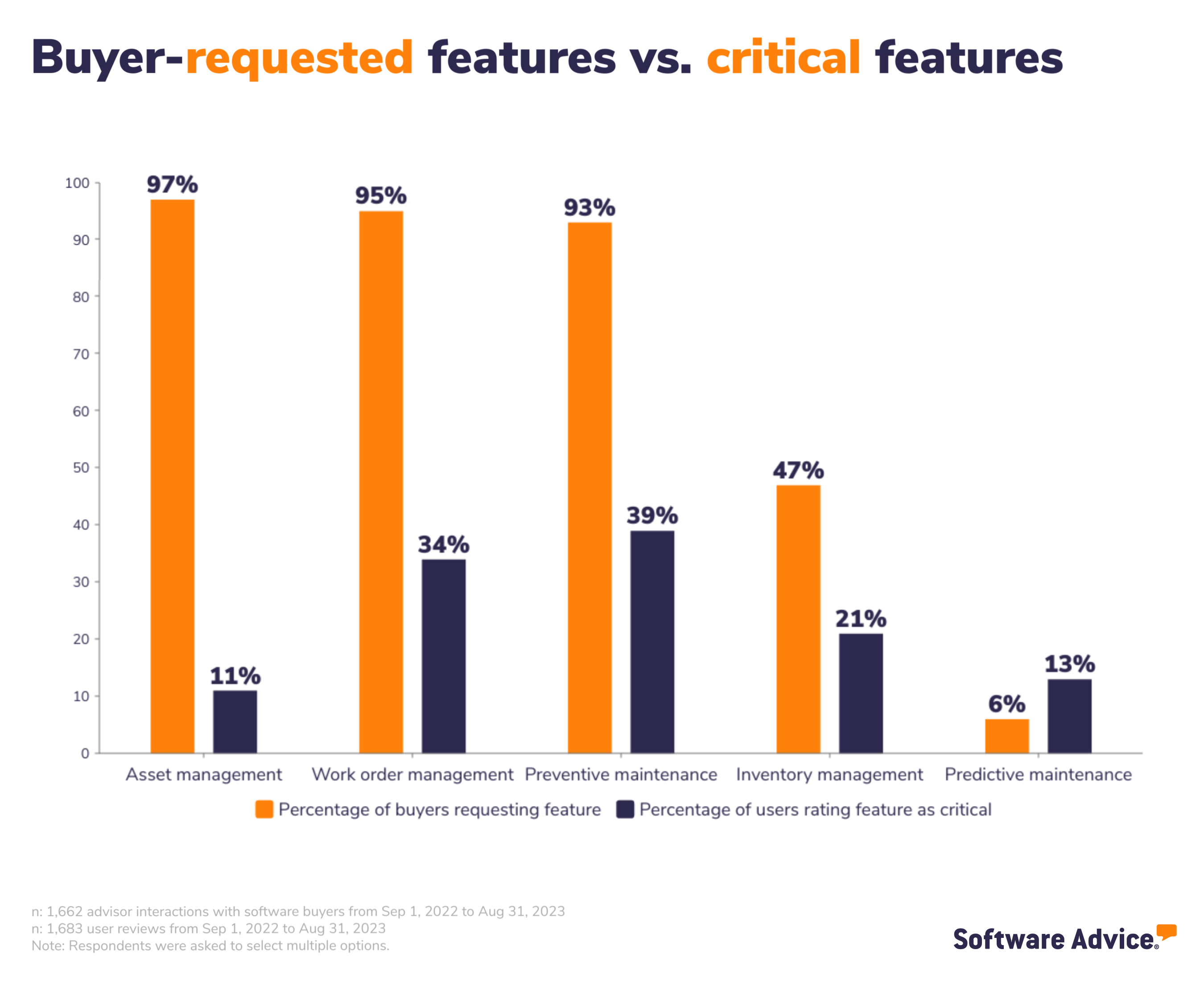
Pro tip
Ensure that the features you want are available in the software you’re opting for. Features such as asset management, work order management, and preventive maintenance are critical for maintenance management needs.
Most businesses either use third-party software or manual methods or have no methods in place for their day-to-day operations
When our advisors asked buyers what methods they were currently using to handle their day-to-day maintenance operations, here's what they found:
Thirty-seven percent of buyers use manual methods to perform daily tasks, such as using spreadsheets to track new work orders, manually assigning tasks to individual team members, and monitoring work progress over calls.
Twenty-five percent of buyers use third-party software that offers limited maintenance management features to track tasks and get reminders about upcoming tasks. However, most of these tools are expensive and misaligned with maintenance management needs.
Manual methods can be time-consuming and make your workforce inefficient as your workload increases. A dedicated maintenance management solution can help centralize tasks such as automated work order creation and tracking maintenance records. The software also helps assign tasks to specific team members, optimizing workforce allocation, and improving overall efficiency.
Consolidating functions within a single maintenance management platform eliminates the need to invest in multiple third-party software and manage their licenses, subscriptions, and integrations.
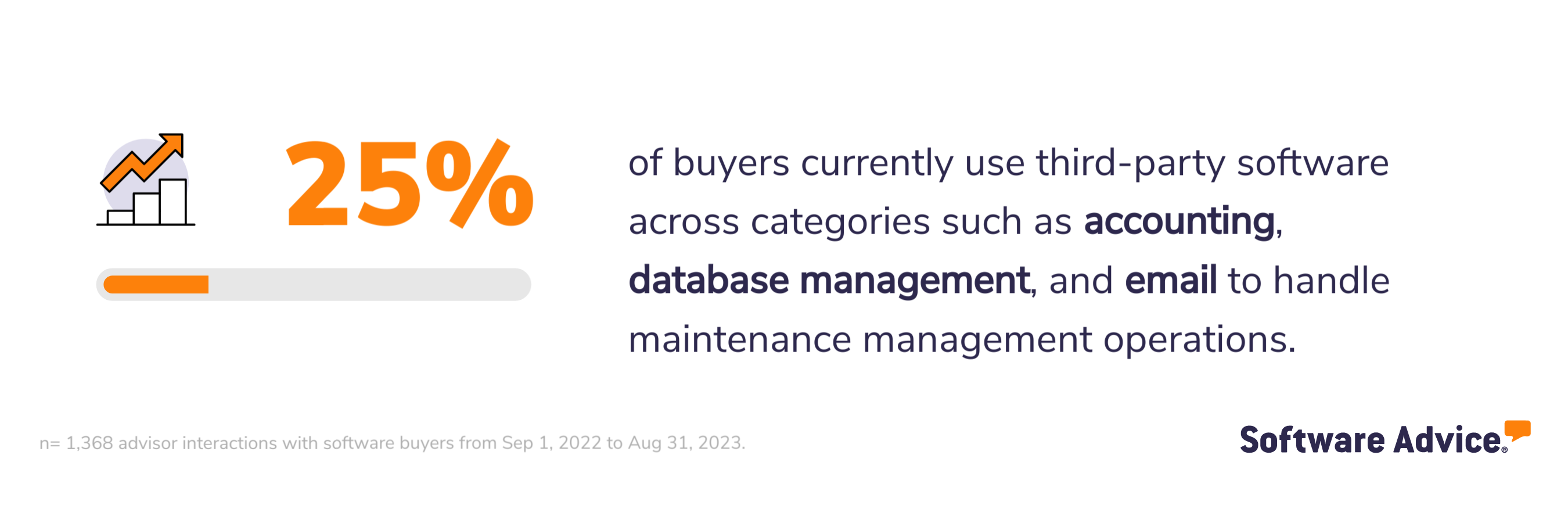
Pro tip
Tailor required software functionality to meet your maintenance management team's specific needs, as data shows varying opinions on critical features for different businesses. Identify your unique requirements rather than simply listing general features. For example, healthcare businesses will prioritize efficient preventive maintenance, equipment durability tracking, and inventory control, while manufacturing businesses will look for machinery tracking.
Inefficiency, limited functionality, and unreliability are key drivers of a switch to maintenance management software
Our advisors conversed with buyers currently using either manual methods or third-party software and seeking a switch to maintenance management software. These discussions shed light on businesses' real-life challenges with their existing tools. These included inefficiency (40%), limited functionality (32%), and unreliability (9%).
Inefficiency: Third-party software either doesn't offer dedicated maintenance management capabilities, such as alerts regarding upcoming jobs or work order assignments or cannot keep track of multiple work orders, making it difficult for teams to optimize their work processes. Buyers using manual methods also find it inefficient to maintain numerous spreadsheets and need help sharing stored data with multiple stakeholders involved in a maintenance work order.
Limited functionality: Third-party tools not tailored to maintenance management may lack specific features crucial for efficient work order management, preventive maintenance scheduling, asset tracking, and other maintenance-related tasks. Maintenance management also involves keeping track of equipment durability, something that third-party software cannot provide.
Unreliability: Buyers using third-party tools for maintenance management needs often face bugs and glitches with such software. These include latency issues that make the software stutter and geographic information system (GIS) integration glitches that affect the mapping of addresses and locations where maintenance work is required.
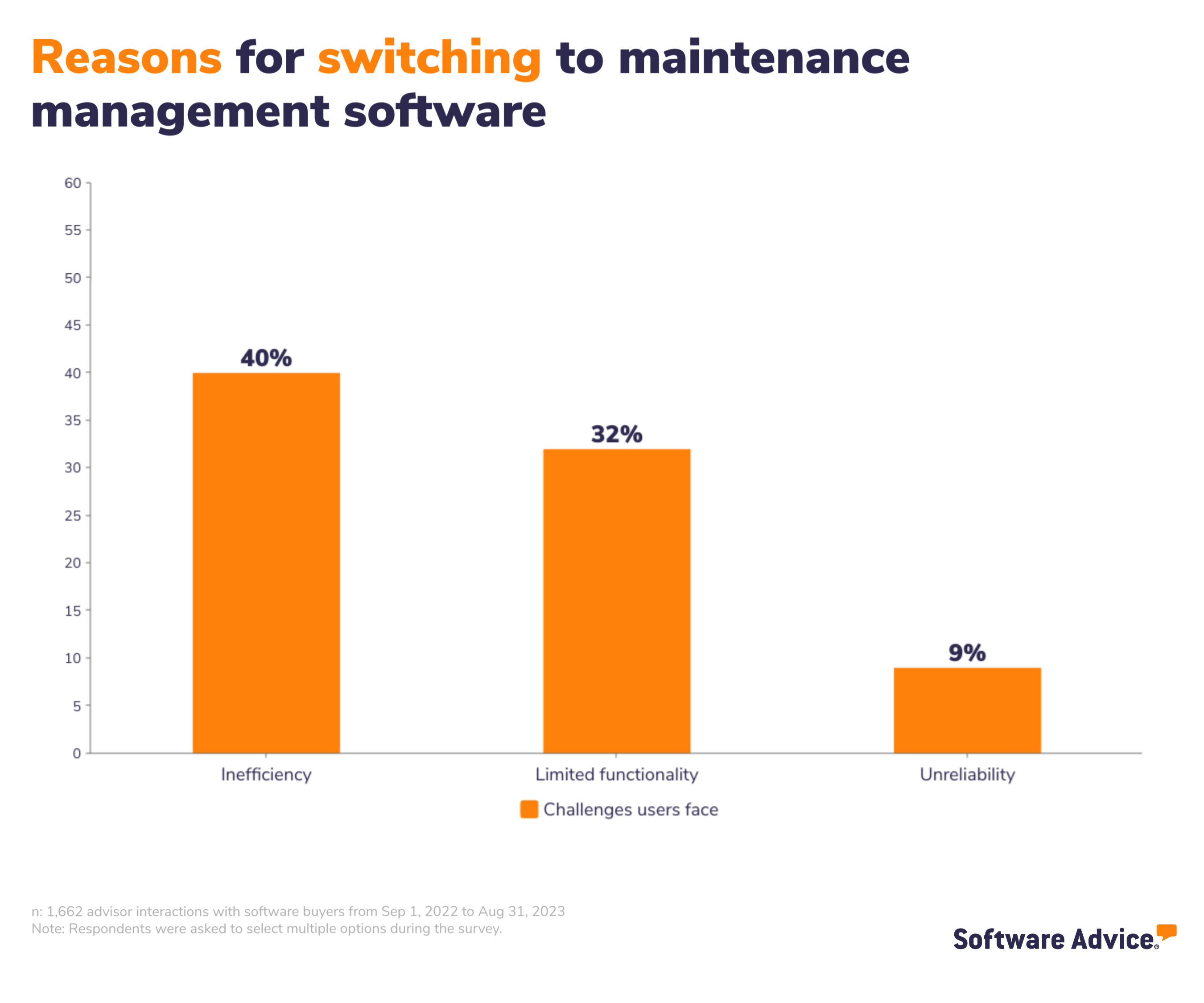
Pro tip
Before making your final purchase decision, look for tools that work well with your industry. Opting for a free trial is a good way to test the compatibility of a tool with your business. With a free trial, you’ll be much more informed and equipped to go into a demonstration with a vendor to maximize the information you can get.
The average buyer’s budget ranges from $95 to $117 per user, per month
The budget for purchasing maintenance management software varies from industry to industry based on factors such as organization size, the number of users, and the required features and functionalities.
However, the average budget across industries for purchasing maintenance management software was approximately $120 per user per month. Additionally, the overall budget came out to be $1440.
The chart below highlights the average buyer budget per user, per month for the top five industries interested in maintenance management software.
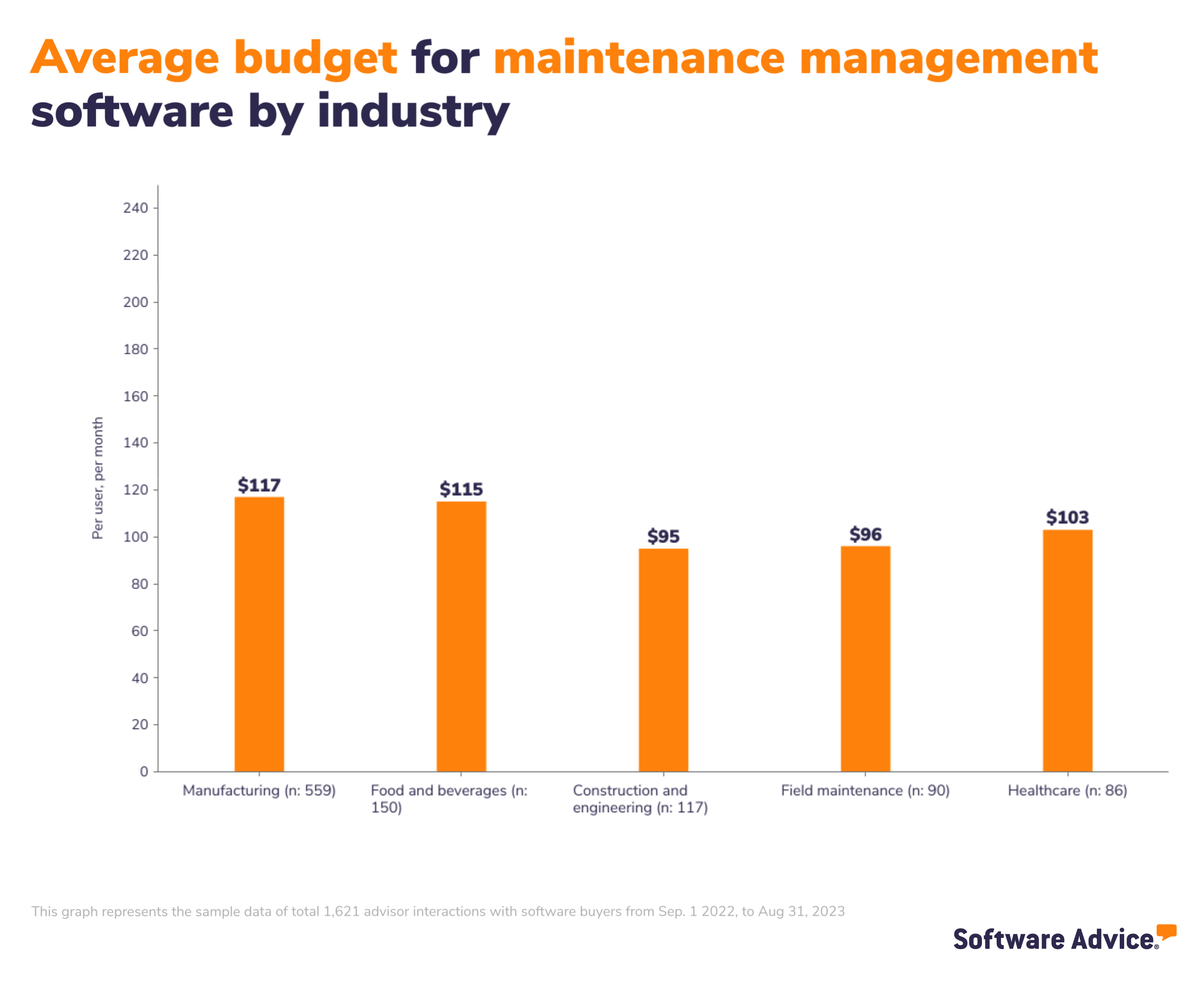
To forecast equipment failure and perform preventive maintenance, manufacturing businesses must efficiently track and manage various manufacturing assets, including equipment, machinery, tools, and facilities. This ensures optimal performance and equipment longevity. Such requirements may affect the budget for manufacturing businesses as their inventory size increases.
Food and beverage businesses have unique needs, such as hygiene and sanitation compliance, for which they must implement and track cleaning and sanitation schedules for equipment and facilities. Additionally, businesses must schedule and automate preventive maintenance for critical equipment, such as ovens, refrigeration units, mixers, and packaging machines, to prevent breakdowns and uphold quality. Such requirements can affect the budget for food and beverage businesses.
Device and equipment maintenance is a high priority for construction, engineering, and healthcare businesses. These businesses must ensure all equipment is in optimal working condition, calibrated accurately, and meets performance standards. Creating work orders for such tasks is crucial; a maintenance management tool can help them achieve this. Such needs may affect the budget for these businesses.
Pro tip
Before deciding on an appropriate budget, take time to evaluate the true cost of your purchase. You should also negotiate your service-level agreement (SLA) with any possible vendors early on to avoid being caught off guard by any hidden fees later on.
More resources for your software search
Whether you’re looking to buy new maintenance management software or replace your existing tool, here are some additional resources to aid your software search:
Start with our interactive maintenance management software directory to compare hundreds of products, filter your search by specific features, and read comprehensive reviews from SMB leaders.
Check out top-rated maintenance management software based on user ratings and popularity in the 2023 Maintenance Management Frontrunners Report.
Review the maintenance management software buyers guide to better understand the market.
Buyer demographics
The buyers we interacted with are mainly small businesses. You’ll find the demographics of the buyers below, so you can see the sizes and types of businesses, from annual revenue to industry.
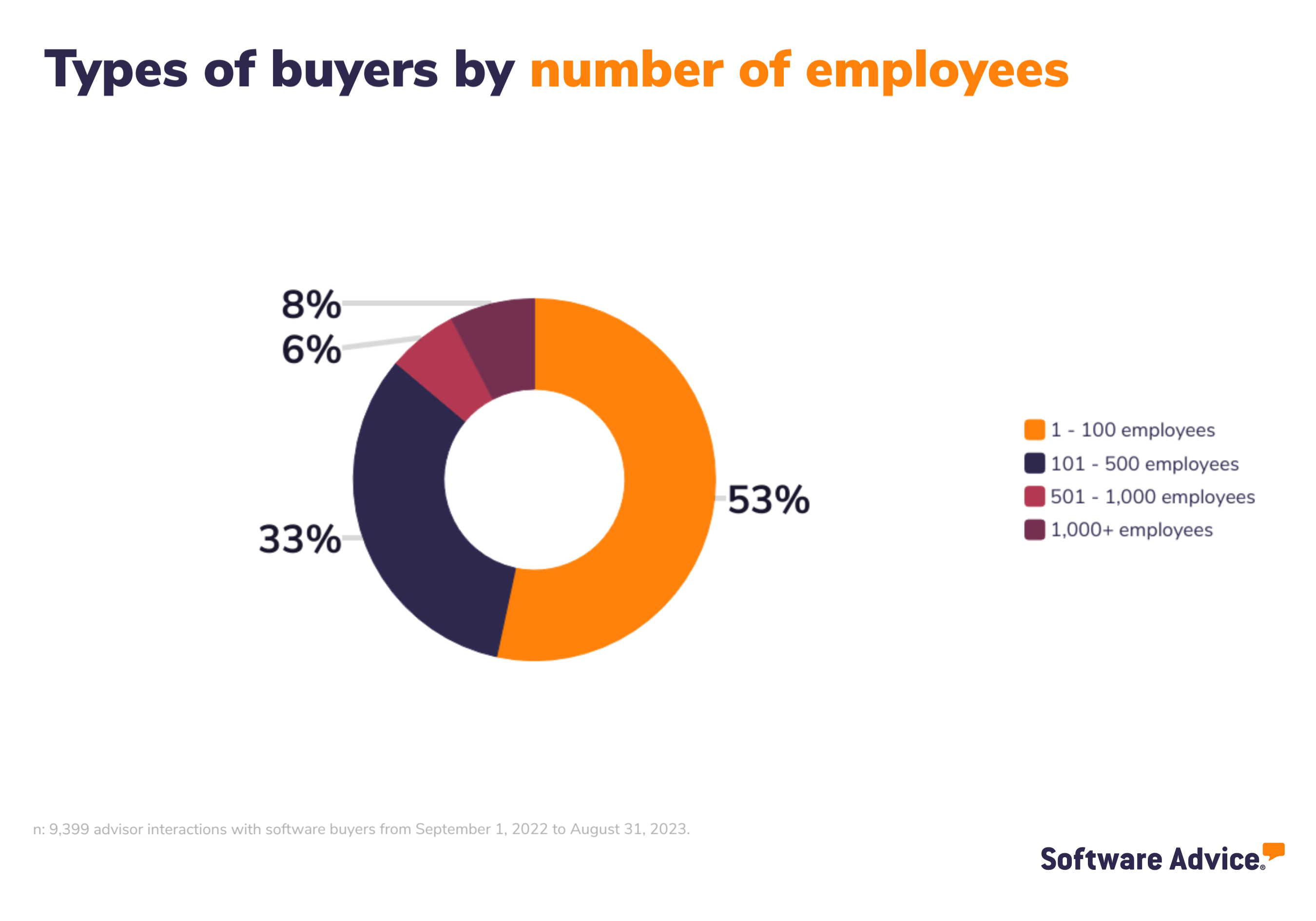
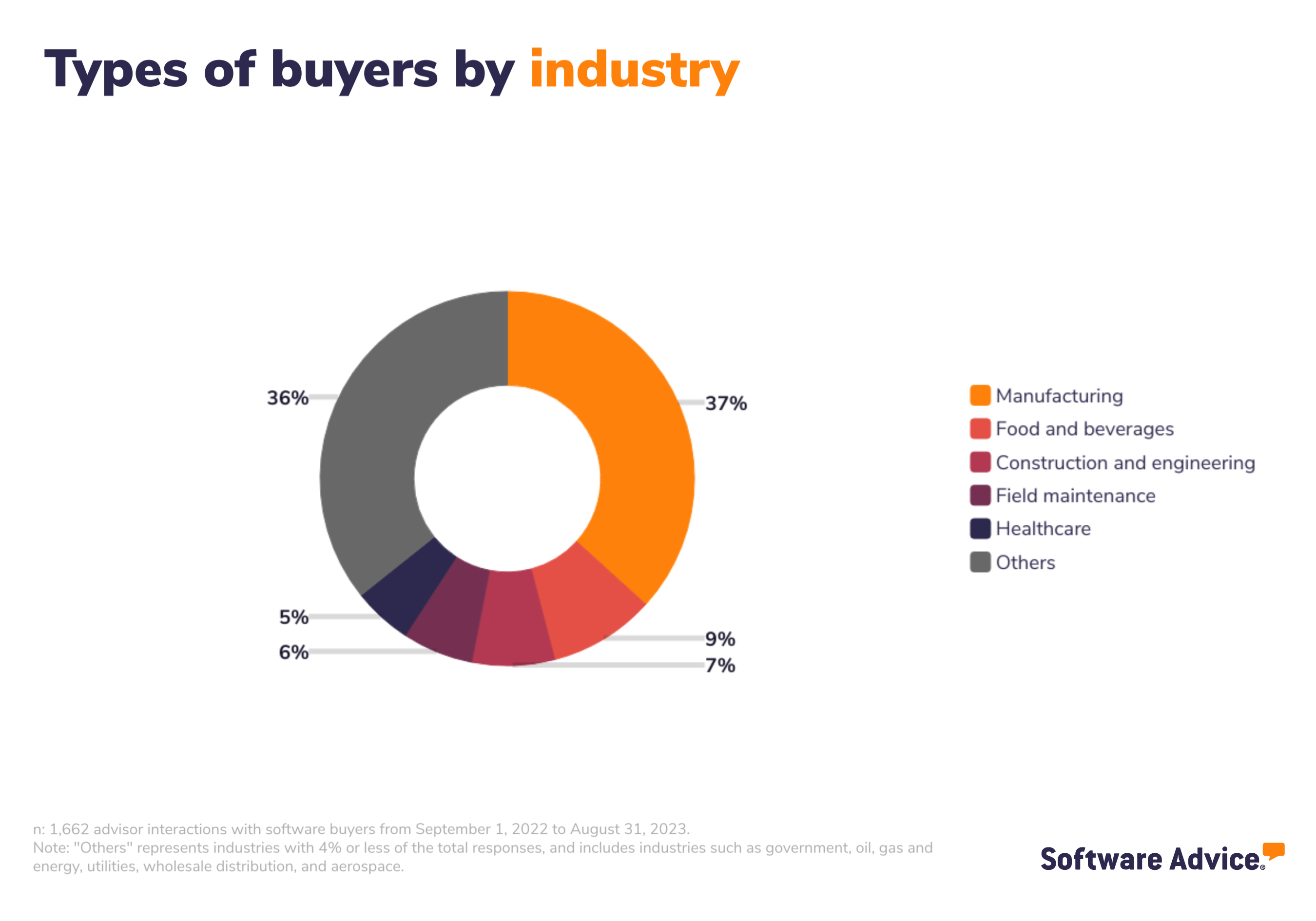

Methodology
Software buyers analysis methodology
Findings are based on data from conversations that Software Advice’s advisor team has daily with software buyers seeking guidance on purchase decisions. The data used to create this report is based on interactions with small-to-midsize businesses seeking maintenance management tools. For this report, we analyzed approximately 8,900+ phone interactions from Sep 1, 2022, to Aug 31, 2023.
The findings of this report represent buyers who contacted Software Advice and may not be indicative of the market as a whole. Data points are rounded to the nearest whole number.